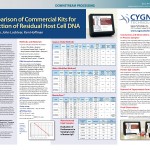 Expression of therapeutic proteins in cultured cells is a cost effective method for production of commercial quantities of a drug substance. However, the manufacturing and purification process of these products leaves the potential for DNA contamination from the host cells. Due to the theoretical potential for the transfer of oncogenes from the host cell, the WHO has set a residual host cell DNA limit of 10ng/dose in biologic therapeutics. Regulatory agencies have set allowable limits between 100pg/dose and 10ng/dose depending on the cell line used as well as the mode and frequency of dosing. These requirements require a sensitive method of DNA detection for compliance. Unfortunately, all of the current methods of DNA detections are severely inhibited by the presence of protein and other buffer components. This poster compared 3 commercial kits that are designed to extract residual host cell DNA on the basis of performance and ease of use. It was found that the samples extracted using the 3 methods generally yielded the similar results. However, the sample compatibility, the quality of the data, and the ease of use of the Cygnus Kit were found to be superior.
Expression of therapeutic proteins in cultured cells is a cost effective method for production of commercial quantities of a drug substance. However, the manufacturing and purification process of these products leaves the potential for DNA contamination from the host cells. Due to the theoretical potential for the transfer of oncogenes from the host cell, the WHO has set a residual host cell DNA limit of 10ng/dose in biologic therapeutics. Regulatory agencies have set allowable limits between 100pg/dose and 10ng/dose depending on the cell line used as well as the mode and frequency of dosing. These requirements require a sensitive method of DNA detection for compliance. Unfortunately, all of the current methods of DNA detections are severely inhibited by the presence of protein and other buffer components. This poster compared 3 commercial kits that are designed to extract residual host cell DNA on the basis of performance and ease of use. It was found that the samples extracted using the 3 methods generally yielded the similar results. However, the sample compatibility, the quality of the data, and the ease of use of the Cygnus Kit were found to be superior.
Sunday November 16, 2025
